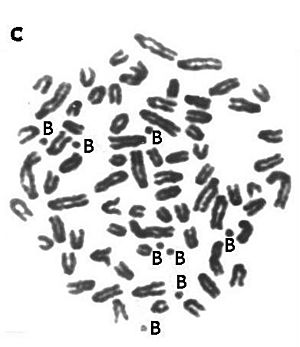B chromosome facts for kids

B chromosomes are extra chromosomes found in many living things. They are not part of the main set of chromosomes that an organism needs to survive. Because they are extra, they are sometimes called 'supernumerary' or 'accessory chromosomes'.
Many different kinds of living things have B chromosomes. These include wild populations of animals, plants, and fungi. These extra chromosomes are not needed for life, and many individuals in a group might not have them at all. So, in one group of animals, some might have zero B chromosomes, while others might have one, two, three, or even more.
What Are B Chromosomes Made Of?
Most B chromosomes are made mostly or entirely of a type of material called heterochromatin. This means they usually do not carry instructions (genes) for making proteins or doing specific jobs in the body. However, some B chromosomes, like those found in maize (corn), have parts made of euchromatin. These parts can carry genes and might code for some products.
Why Do Organisms Have B Chromosomes?
It seems strange that these extra chromosomes would stay in a species if they didn't offer some kind of benefit. In a few cases, scientists have found a positive reason for them. For example, a British grasshopper called Myrmeleotettix maculatus has B chromosomes that contain special DNA. These grasshoppers are found more often in warm, dry places. They are rare or not found at all in cool, wet areas. This suggests the B chromosomes might help them survive better in certain environments.
Scientists think that B chromosomes might act a bit like parasites or "selfish DNA." This means they might exist simply because they can copy themselves and pass on to the next generation, even if they don't always help the organism. Scientists have many ideas about how these extra chromosomes first appeared.
See also
 In Spanish: Cromosomas B para niños
In Spanish: Cromosomas B para niños

